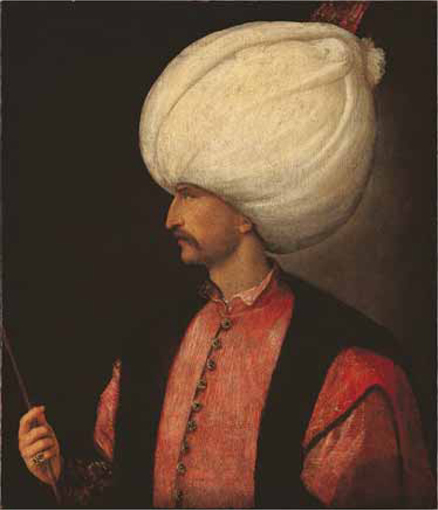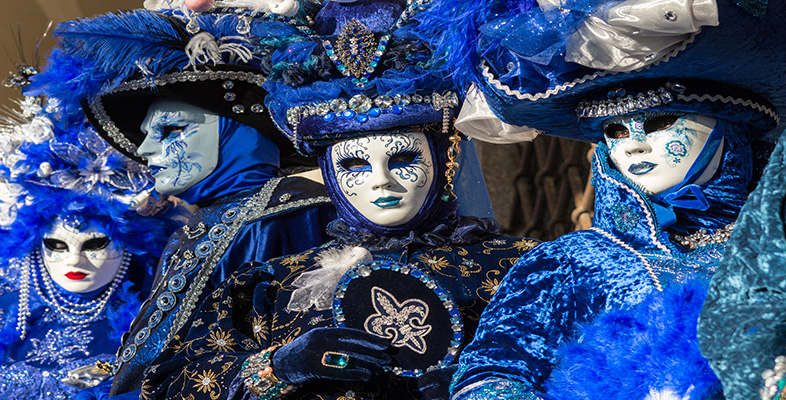3 A portrait
One of the most intriguing portraits of the Renaissance period is of the Ottoman Sultan Mehmet II, the conqueror of Constantinople. Painted from life in 1480, its author is the Venetian painter Gentile Bellini (c.1429–1507) (Figure 14). These are curious conjunctions. What was an Italian painter doing in a Turkish court? Why did an Islamic monarch want to have his portrait painted by a western, Christian artist? In a sense, this modest picture figures not just a man, but the relationship between two cultures.
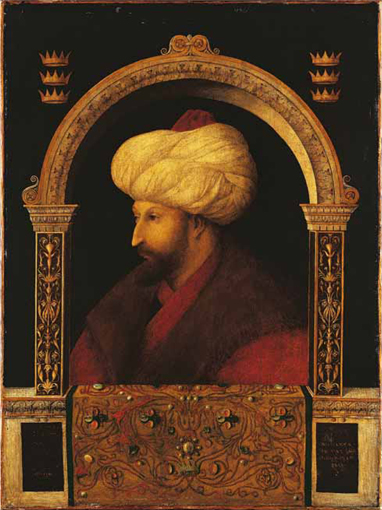
Gentile Bellini was the elder brother of Giovanni, and by the common consent of later generations, the lesser artist. What Gentile lacked in talent, however, he made up for in terms of organisational skill. It was he who took over the family workshop after the death of Jacopo in c.1470, and he who became the most powerful artist in late fifteenth-century Venice. One historian calls him ‘the principal impresario’37: he gained the most important commissions for the decoration of the Grand Council Chamber in the Palazzo Ducale in 1474 as well as others for the scuole grandi, received a knighthood from the Holy Roman Emperor and became the focal point of the diplomatic mission to the Ottoman court that issued in his portrait of Mehmet II. Furthermore, this was not just any court. In the second half of the fifteenth century, after 1453, the Ottomans emerged as not only the one serious imperial rival to Venice in the eastern Mediterranean, but for the next 100 years a real challenge to the hegemony of western Christendom as such.
Mehmet ascended to the Ottoman throne for the second time in 1451, aged 19. 38 His original tenure as an adolescent had been unsuccessful and his father had needed to come out of retirement and reassume power. After his father’s death, Mehmet did not fail for a second time. He immediately began building his military power, and a policy of expansion rapidly led him to the siege of Constantinople. The city was by then almost all that remained of the former Byzantine Empire. The large Ottoman army and navy, estimated at 80–100,000 men, faced a defending force of only about 7,000. Despite the imbalance of forces, the siege lasted 55 days, but on 29 May 1453, a date perceived as one of European history’s turning points, Constantinople fell to the Turks.
News of the fall of Constantinople, which reached Venice a month after it happened, and Rome a week later in July 1453, set off a panic in Christian Europe. Nonetheless, the immediate reaction, to unite in a crusade to retake Constantinople from Islam, foundered on the reefs of internecine squabbling and self-interest on the part of individual states. Before the end of the year, Venice had concluded a treaty which established a permanent embassy in Turkish Constantinople, and secured the continuing domination of Venetian trade in the eastern Mediterranean (something for which collective excommunication by the papacy for betraying Christendom was deemed a fair price to pay). 39 The peace lasted a decade, but was then followed by a draining 15-year war between Venice and the Ottomans which broke out in 1464. This history has a bearing on Bellini’s portrait. By 1478 Venetian wealth and trade had become so adversely affected as a result of the war that peace negotiations were opened. The experienced diplomat Giovanni Dario travelled to Constantinople charged with acceding to as many demands as were necessary to preserve Venetian trade in the region. The terms of the treaty concluded on 25 January 1479 were harsh for Venice, including financial reparations for the costs of the war and the payment of an annual rent for trading within the Ottoman Empire.
On the positive side, the permanent ambassador, or bailo, in Constantinople was re-secured. Mehmet, meanwhile, had built up the city from the impoverished and depopulated shell it had been after the conquest a quarter of a century earlier into a new capital of 60–70,000 inhabitants. A relevant notion to consider at this point is the western image of the barbaric oriental despot. Recent research has shown that, rather than being a constant figure of relations between the Christian West and Islam, this notion crystallised only in the late sixteenth century. 40 For well over 100 years, from the fall of Constantinople until the last quarter of the sixteenth century, fear of the Turks was mixed with admiration for their social system, which seemed to grant them in equal measure irresistible military power and enviable cultural riches. The same Mehmet who was responsible for thousands of executions and was in one report described as ‘feared and dreaded, ruthless and cruel … a second Nero and far worse’41 also reputedly spoke several languages, wrote poetry and possessed considerable knowledge of the literature and philosophy of antiquity. An eye-witness, subsequently quoted in a contemporary Venetian chronicle, reported that before the siege of Constantinople, Mehmet enjoyed daily readings from ‘ancient historians such as Laertius, Herodotus, Livy and Quintus Curtius and from chronicles of the popes and Lombard kings’. 42 Kritovoulos of Imbros, a Greek scholar, recounted how he ‘used to read philosophical works translated into Arabic from Persian and Greek and discuss the subjects which they treated with the scholars of his court’. 43 What matters here is less a question of the objective truth or otherwise of the claim, than of how Mehmet’s identity was being fashioned. At about the same time Vespasiano da Bisticci wrote of Federigo da Montefeltro, Duke of Urbino, that ‘He was ever careful to keep intellect and virtue to the front, and to learn something new every day’, going on to catalogue his patronage of the arts, architecture and music, as well as his deep knowledge of both classical authors and the scriptures. 44 Half a century later, no less ambiguous a figure than Henry VIII was recorded as frequently receiving Sir Thomas More into his private apartments, ‘and there sometime in matters of astronomy, geometry, divinity, and other such faculties, and sometimes of his worldly affairs, to sit and confer with him’. 45 The point is not, therefore, that Mehmet’s learning (nor indeed Henry VIII’s) was incompatible with brutality, but that Mehmet’s identity was being constructed not as an alien despot, but as a characteristically Renaissance prince. 46
One of Mehmet’s most important projects was the construction of a new palace complex in Constantinople – the Topkapý Palace – from which the Ottoman Empire was administered. Although many Christian churches were taken over and converted into mosques, the Orthodox Church had been re-established, and a degree of multiculturalism with Christians and Jews existed within the overall Islamic culture of the city. Mehmet continued his personal fascination with the West, partly, it would seem, for its intrinsic interest, partly for strategic ends – building up knowledge of contemporary Italy with a view to its eventual incorporation into the Empire. According to the then widespread view of world history as rooted in the Old Testament Book of the prophet Daniel, the four pagan empires of Babylon, Persia, Greece and Rome were to be followed by a fifth empire uniting the world. It was not unusual for Renaissance scholars in the late fifteenth and early sixteenth century to worry that with Christendom prey to internecine warfare, this empire would be Islamic. In 1521 a report by the Venetian ambassador stated that the Sultan ‘holds in his hands the keys to all of Christendom’, and as late as 1576, it was still being lamented that ‘the fall of such an empire by the hands of men is therefore the vainest thing to think of’. 47
In discussions with the Venetian delegation during the peace negotiations of 1478–9, Mehmet’s interest in western culture, contemporary as well as classical, seems to have been a topic that arose – including his grasp of the tradition whereby rulers reinforced their power through the circulation of images of themselves on coins and medals. As an experienced Venetian diplomat, Giovanni Dario was, of course, fully conversant with the artistic situation in Venice, and one of the requests that emerged from Constantinople in the summer of 1479 was for a ‘good painter’ to make medals and to paint the Sultan’s portrait. 48 After 1453, Venice had lost a string of important colonies in the eastern Mediterranean, with consequent damage to its overseas trade. For both military and commercial reasons, Venice needed to secure its accommodation with the Turks; complying with Mehmet’s artistic desires – both in terms of palace decoration and the dissemination of his own image – was going to be a useful means to this greater end. One is reminded of Michael Baxandall’s observation that ‘in the fifteenth century, painting was still too important to be left to the painters’. 49 In short, the Venetian government would have done all it could to satisfy Mehmet’s desire to propagate his image. Within a month of receiving the request, a painter was on his way. The leading artist in Venice at the time, in charge both of the decoration of the Grand Council chamber in the Palazzo Ducale and of producing the official portrait of the doge, was Gentile Bellini.
Portraits of the doges were displayed in a frieze above the Venetian history paintings in the council chamber. In keeping with the corporate spirit of Venetian life the point of them was less to celebrate the individual and his achievements than to represent the individual as part of a collective – the head of a family, officer of a scuola or, in the ultimate case, the doge. The most renowned representation of this absorption of individual personality into that of the office-bearer is Giovanni Bellini’s portrait of Doge Leonardo Loredan of 1505, now hanging in the National Gallery in London. But before that, artists were producing more hieratic and austere bust-length images, modelled on antique coins. Gentile’s portrait of Doge Giovanni Mocenigo (Figure 15), completed just before the summons to Constantinople, shows him facing left, in profile, his elevated status conveyed by the flat gold ground, the gold collar and the characteristic horned hat, the cornu, embossed with geometric designs. Following an established formula, only the doge’s face is lightly modelled, conveying just sufficient information for the painting to qualify as a portrait rather than a stereotype. There seems little doubt that Gentile Bellini’s ability to fulfill contemporary requirements for an individuated likeness, combined with a classically legitimated sense of the gravity of office, led to his being chosen for the mission to Constantinople in 1479.
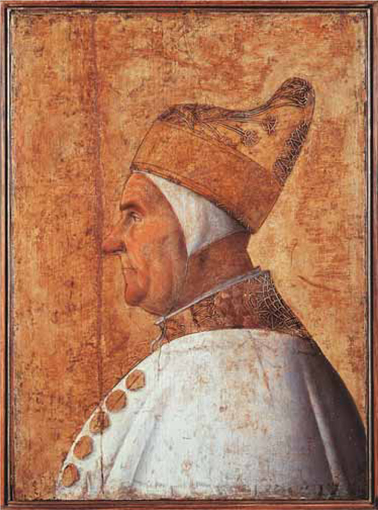
In some ways, the surprising thing about Gentile Bellini’s year and a half long sojourn in the Ottoman capital is what he did not do. Because of his prestige in Venice, Gentile was for long regarded as the father of an ‘Orientalist’ style that emerged in Venetian painting around the turn of the sixteenth century. But in fact he produced no images of Ottoman society, no paintings of contemporary Ottoman architecture or social life to equate with those on which his reputation in Venice rested. He did, however, make several studies of individual Turkish people in daily costume, which formed the basis for many subsequent depictions of Turks and other Orientals in western art (Figure 16). Gentile was the best known, but not the only, western artist involved with the Ottoman court. Slightly earlier another painter, Matteo de’ Pasti, had been arrested as a spy by the Venetians in Cyprus, en route to Constantinople, for having in his possession maps of Italy. More successful was the Venice-born Costanzo da Ferrara, sent by the King of Naples, who was there during the late 1470s, possibly 1478. 50
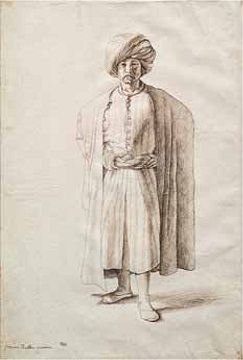
The principal work of Costanzo’s to have survived is his portrait medal of Mehmet of c.1480 (Figure 17a). This image of a powerful man provides an interesting instance of the way images of Orientals entered art, often built up from a single actual observation. Costanzo’s model was Pisanello’s portrait medallion of the Byzantine Emperor, John VIII Palaiologos, made at the time of the Council of Orthodox and Catholic Churches in 1438–9. 51 The portrait of Mehmet is comparable to Pisanello’s image of the Byzantine Emperor, not least through its use of exotic headgear to signify ‘otherness’. The reverse of the medal shows an equestrian image of the Sultan (Figure 17b). This has its roots in a sheet of drawings by Pisanello, apparently life studies of the Byzantine Emperor’s entourage. They show the emperor standing, clad in a full-length cloak, some details of the cloak’s embroidered hem, and another image of the emperor, mounted on horseback and wearing the characteristic Timurid hat. 52 This observed image, adapted for the circular proportions of Pisanello’s medal, was in turn used as the compositional basis for the equestrian portrait on the reverse of Costanzo’s medal of Mehmet 40 years later.
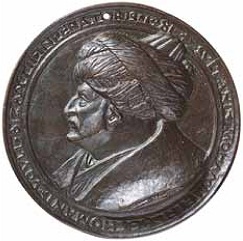
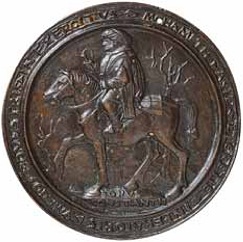
Subsequently, this image became transformed into a generic representation of an ‘Ottoman rider’ by no less a figure than Dürer during his first visit to Venice in 1495 (Figure 18). Rosamond Mack has remarked of this kind of borrowing that ‘artists tended to adapt a small repertory of authentic images to a variety of representational uses’, concluding that what they reveal, despite the level of commercial contacts between East and West, is ‘a limited vision of the Orient’. 53 Dürer seems also to have had access to Gentile Bellini’s studio in 1495 and to have seen work in progress on his monumental painting of a Procession in the Piazza San Marco (see Section 4). Dürer was interested in collecting exotic types for subsequent incorporation into his own pictures, and to this end made a copy of one of Bellini’s preparatory studies of Ottoman figures in the background of the picture, presumably sketched from life during Gentile’s earlier sojourn in Constantinople (Figure 19). Dürer went on to incorporate many of the oriental types he collected in Venice into subsequent compositions. Sometimes these could be positive, as in the Map of the Northern Sky he made in 1515. The four corners of Dürer’s print show eminent scientist-philosophers of the ancient world, including, along with Ptolemy of Egypt, ‘Azophi Arabus’ – testimony to the status of Arabic learning. More often, however, such figures function as negative signifiers of the ‘Other’ in his woodcuts and engravings of a variety of biblical scenes. The Martyrdom of Saint John the Evangelist from the Apocalypse series of 1496–8 is notable for its inclusion of a negro and a Jew as well as three turbaned Orientals variously observing and presiding over the Christian saint’s agonies (Figure 20). Western perceptions of Islam during the fifteenth century were perhaps not as one-dimensional and stereotypical as they subsequently became, but for every representation of a scholar or a Renaissance prince, an oriental despot could be found lurking in the shadows of the European imagination.
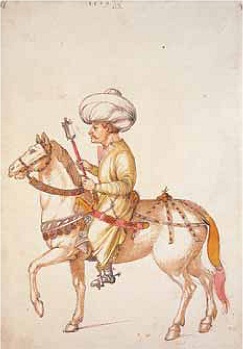

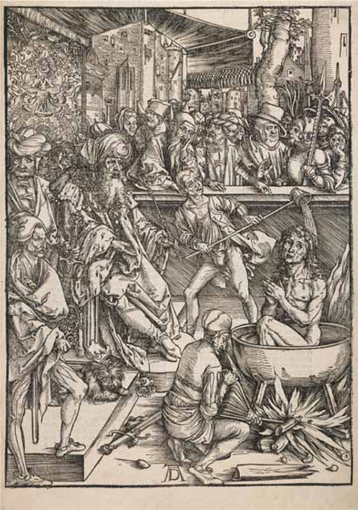
Gentile Bellini also produced a portrait medal of Mehmet, either during his time in Constantinople or shortly after his return. It was slightly smaller than Costanzo’s, albeit very similar in format, and gave a markedly less robust image of the Sultan. The outstanding work to survive from Gentile’s mission to Constantinople, however, is his oil portrait of Mehmet, dated in its inscription at the bottom right to 25 November 1480 (Figure 14). By this time Mehmet the Conqueror – the title he had assumed on capturing Constantinople a quarter of a century before – was 50 years old and in ill health. He had retired within the confines of the palace, and was principally preoccupied with its decoration and with the cultivation of a garden. He is represented in the painting in the bust-length profile familiar from the medals, and also from the contemporary portraits of the eminent Venetians. The image, however, has a pensive, scholarly air, more marked even than Gentile’s medal, and quite dissimilar to Costanzo’s thicker-set, somewhat belligerent-looking figure. In all three, the sultan is depicted wearing the distinctive Ottoman taj, the turban in which a length of white material is wound around a stiff, ribbed cap in red felt. He also wears a similar garment, a kind of shirt with a cross-over collar, under a deep-red kaftan with a broad fur collar. In the painting, the archway in which he is framed is represented in a western perspectival style, with decoration suggestive of classical candelabra and tracery. But draped over the lintel is an opulent oriental fabric decorated with jewels. Apart from the date, the legible part of the inscription reads ‘Victor Orbis’ – conqueror of the world. The significance of the crowns, for all the prominence of their placement, is unclear. On the reverse of Bellini’s portrait medal there are three of them, usually taken to refer to the three components of the Ottoman Empire – their own original territories in Asia, Greece (including Constantinople) and Trebizond (the Black Sea port and gateway to the Silk Route into central Asia, captured by Mehmet from Venetian control within a decade of the end of Byzantium, in 1461). 54 More recently, however, it has been suggested that the six crowns in Bellini’s oil portrait represent the six previous Ottoman sultans, with Mehmet himself symbolised by the seventh crown, made of pearls, at the bottom centre of the jewelled textile right at the front of the painting. 55
Bellini left Constantinople in January 1481. Mehmet was dead within a year, and his iconoclastic successor sold or destroyed the western-style figurative art he had commissioned for the Topkapý Palace. Legend has it that the sultan’s portrait was bought for a knock-down price in the marketplace by an observant Venetian merchant, and subsequently transported home. Interestingly, however, Bellini’s portrait did leave a trace in Ottoman art. 56 There survives a portrait attributed to Shiblizade Ahmed from the same time which appears to draw on the same pose – the profile portrait, the cross-over collared shirt, the fur-collared Kaftan, the tāj – as well as to employ western shading to suggest volume in areas such as the handkerchief, turban and face, in contrast to the Ottoman convention for flat, unmodelled planes (Figure 21). Where this picture departs from Bellini’s portrait is in the inclusion of the oriental cross-legged sitting posture, and the enigmatic device of having the sultan smell a rose. This is an image which recurs in later Ottoman portraits but whose precise meaning is unclear. One possibility is that it refers to the grace of Paradise; another is simply that Mehmet was renowned for the pleasure he took in the cultivation of his garden.
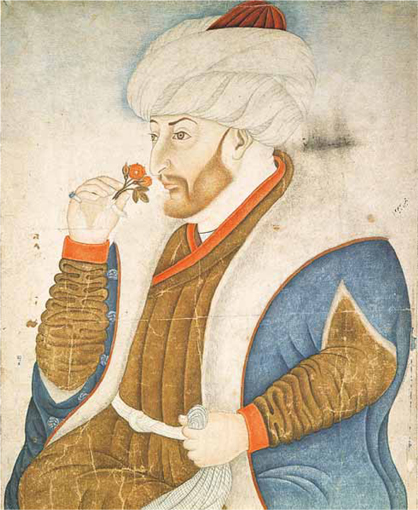
Be that as it may, this story of the image of the Ottoman sultan is inseparable from the larger story of two societies and their interaction – economic, cultural and military. A generation later, when the pressure of the Turks on Christendom reached its highest point, the studio of Titian produced another profile image of a Turkish sultan: Mehmet’s descendant Sulyeman the Magnificent (Figure 22). Probably based on studies by European envoys to the Ottoman court that were intended to be used to illustrate the many printed books on the threat of expansionist Islam, the painted portrait is an arresting image. Headgear had become the principal visual signifier of the ‘Oriental’, and here it reaches a climax. The fact of its authorship by the most eminent workshop of the day, its unstable mix of authority and otherness, of majesty and caricature, says much about the ambiguous power of ‘El Gran Turco’, as he was widely known, in the European imagination of the time. 57
